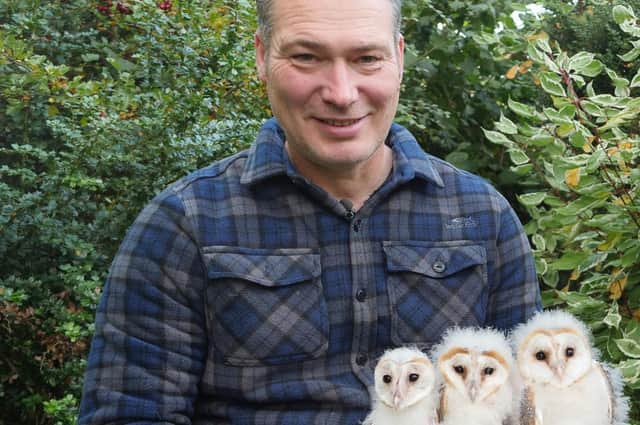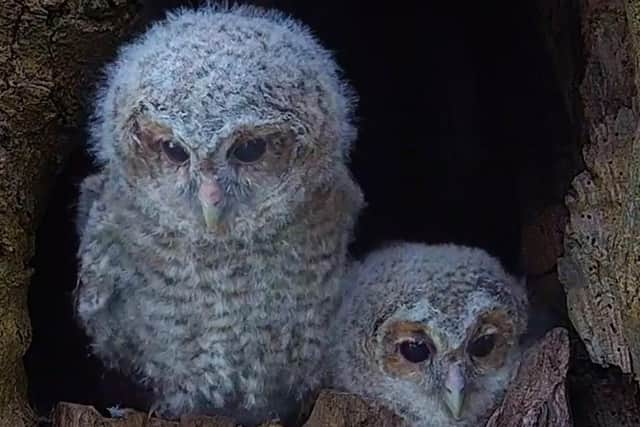Artist Robert E Fuller watches the wildlife in his garden get ready for winter


The birds spent much of their time gorging on the season’s berries whilst the squirrels foraged furiously for nuts.
And at my home in Thixendale, the garden birds feverishly fattened themselves up for winter. A brand new camera, hidden right next to their feeding post, recorded razor-sharp close-ups of robins, blue tits, coal tits, and chaffinches in stunning detail and I shared the footage live on my YouTube channel.
Advertisement
Hide AdAdvertisement
Hide AdBut not all the wildlife seemed to be as involved in these hectic preparations for winter. A barn owl, who lives here year-round, was completely caught out by the sudden snowfall that Storm Arwen brought.


I have followed the life of this male barn owl, named Finn, closely over the year and so when one day I headed down a tunnel that links my home to my wildlife hide so I could check up on how he was coping with the cold, I was surprised to find him covered in snow, his beak and feathers glistening with the icy crystals.
The tunnel I built goes under the garden and means I can get up close to the wildlife without being spotted. But now that I have so many cameras dotted round the garden and surrounding countryside, I can also watch the action from inside.
This means I don’t miss a thing. And so, as I followed the wildlife busy preparing for the coming cold, I also tracked the lives of those animals setting off to navigate life on their own for the first time.
Advertisement
Hide AdAdvertisement
Hide AdBy august, the juvenile stoats had left the company of their litter and seemed to relish their new independence. I watched on my cameras as they learned to hunt. They were not always successful!
Some of the wild animals I care for also made their way into the wild this autumn. Domino, a rescued weasel, was released in plenty of time to prepare for the coming winter, and I placed another weasel rescue, KitKat, in an outdoor enclosure to prepare her for life in the wild.
This tiny weasel is still too young to release, but I tried to replicate her natural habitat by filling the enclosure with leaves and she seems to love them.
The tawny owls that grew up close by, whom followers of my YouTube channel named Bramble and Sage, also flew off to find new territories this autumn. But not before we watched them learn how to fend for themselves and overcome the odd blunder.
Advertisement
Hide AdAdvertisement
Hide AdOn one occasion, the hidden cameras caught the younger owlet, Sage, trying to land on a branch that was floating in a pond. The owl chick got a shock when the log began to roll under his weight and quickly took off in fright!
It’s normal for tawny owls to chase their chicks out of their territory once they are grown, and so, although it was sad to hear such loud hooting and ‘kee-wick’- ing ring across the valley as they chased poor Bramble and Sage away, at least the resident pair are still here to see.
But one pair of barn owls, named Ghost and Willow, unusually, were still nurturing new life as winter crept in. This pair had a very late brood of chicks and were caring for them right up until November.
Barn owls usually lay in May or June, so I was surprised when in August I noticed this pair inspecting the owl nest boxes in my garden.
Advertisement
Hide AdAdvertisement
Hide AdThe pair had been through the process of trying to find a nest in spring but never quite seemed happy with the various owl boxes available in my garden.
That is to say, the female, Willow, was very keen on one box, made from an old sycamore stump, and seemed so set on that one that nowhere else would do. So, when her mate, Ghost, lost the battle for this particular box to a kestrel family, she would accept no other alternative.
She seemed so determined to lay in the sycamore box, she waited until the kestrel chicks had fledged and then moved back in to finally lay her eggs – two months after this species normally lays. As I watched the action on cameras hidden in the nest, I grew worried this late brood may not survive the coming cold.
But although this barn owl pair were slow off the mark, four fluffy chicks hatched in early September, and it was amazing to see these new owl parents brood and feed their tiny young.
Advertisement
Hide AdAdvertisement
Hide AdSadly, the youngest chick did not make it, but the remaining three quickly became boisterous birds of prey and it was wonderful to watch as they practised flapping their wings and grooming their new flight feathers.
Barn owls are a highly protected species here in the UK and so where possible the British Trust for Ornithology try to give individual birds metal tags, or rings, with unique numbers engraved into each so that they can be monitored throughout their lives.
When Willow and Ghost’s chicks were six weeks old, BTO registered ringer Jean Thorpe, of Ryedale Rehabilitation, visited to clip ID rings on them. This is the ideal age to ring an owlet since they are less dependent on their parents.
At this age, it’s also easier to tell males and female barn owls apart. The females have a dark rim around their heart-shaped faces. They also have golden dots that look like sparkles on their breast feathers. We found out then all three barn owlets in this late brood were females and the YouTube community named them Ginger, Cinnamon and Clove, or, collectively, the Spice Girls.
Advertisement
Hide AdAdvertisement
Hide AdAs Christmas approaches and I begin to spend more time indoors with my own family, it’s great to see these owls flit past my window and to think about what new characters will arrive here next year and what new wild adventures I will follow.
Robert’s paintings and live nest cameras are on show at his gallery in Thixendale during the Christmas period. Go to robertefuller.com for opening times. View wildlife footage at youtube.com/c/robertefuller